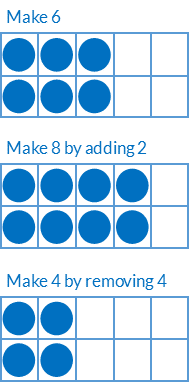16) Bonds
Doubling and Halving to 10: Building a Wall
Mathematics
Develop the concept of doubling and related halving for the wholes 2, 4, 6, 8, 10.
Section One: Linear Representation

Section Two: Ten Frame Representation

Language
- double bond: a two-part bond, where both parts are the same
- double
- one half of
- addition as “and”
- equals as “is”
- ten frame
- empty ten frame


Differentiation
A little easier
Ten Frame: pair wise filling
Students need to be able to represent doubles fluently with counters on a ten frame before using Bond Blocks on the empty ten frame. This fits within the Concrete-Representational-Abstract progression. Counters are a concrete manipulative and and come before Bond Blocks, which are representational manipulative. For more information about using counters and fingers to support learning number bonds click this link.
Instruct students to fill a ten frame with counters using pair wise filling.
- First make 2,4,6,8 10 in counting order.
- Then remove counters in pairs to count backwards making 10,8,6,4 and 2.
- Finally call doubles (2/4/6/8/10) in random order. Students fill their frame with this amount of counters. Before the next double is called students do NOT clear their ten frame. Instead they alter the number of counters on the frame to make the new quantity. Doing this helps students learn about the comparative size of numbers eg 8 is 2 greater than 6.


A little harder
Activity 57
Students who have completed up to Ten Plus Bonds: Addition and Subtraction Ten and One can complete a similar activity for wholes in the teens. Complete Activity 57 Doubling and Halving to 20: Bonds Building a Wall.
Progression
In the next activity students develop fluency with double bonds when they are presented in random order. Go to
Activity 17
Doubling and Halving to 10: Fluency Doubles, Filling A Wall
